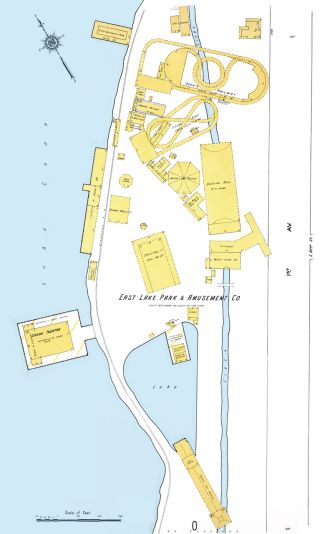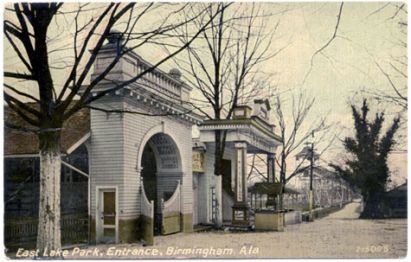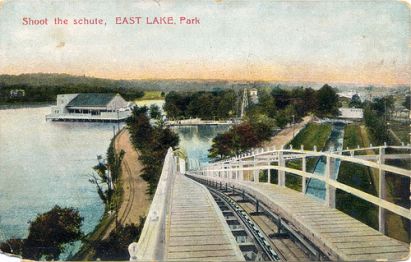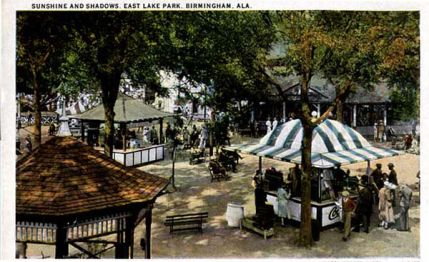East Lake Park: Difference between revisions
No edit summary |
|||
| (6 intermediate revisions by the same user not shown) | |||
| Line 1: | Line 1: | ||
{{About|the park surrounding a man-made lake|other uses|East Lake (disambiguation)}} | {{About|the park surrounding a man-made lake|other uses|East Lake (disambiguation)}} | ||
[[File:1911 East Lake Park Amusement map.jpg|right|thumb|325px|1911 map showing amusements at East Lake Park]] | |||
'''East Lake Park''' is a 100-acre [[List of Birmingham parks|city park]] anchoring [[Birmingham]]'s [[North East Lake]] neighborhood, between [[1st Avenue North]] and [[3rd Court North]] and between [[80th Street North|80th]] and [[84th Street North]]. It adjoins [[Lynn Park]] across [[4th Avenue North]]. | |||
The park was first developed in [[1886]] as a private attraction for the [[East Lake Land Company]]. The 45-acre lake, originally called '''Lake Como''' was created by damming [[Roebuck Springs]] and [[Village Creek]]. [[A. W. Haskell]] was the engineer responsible for the design of the 30-acre (2,200 feet by 800 feet) artificial lake, which ranges from four to 14 feet in depth. The amenity was immediately popular with recreational boaters. In good weather rowboats, sculls, and naptha launches competed for space on the water. | |||
The [[East Lake Railroad]] began bringing visitors to the newly-developing area on [[June 14]], [[1887]], though the basin was not filled until after the water was turned on at noon on [[November 25]]. The next spring the lake was able to fulfill its function of attracting day trippers from Birmingham, who might then be tempted to purchase home lots or businesses in the company's newly-developed subdivision. | |||
The company constructed various recreational facilities in the park, including a [[East Lake Hotel|resort hotel]], a dance pavilion, and pleasure boat docks. Additional attractions, including a ferris wheel, shooting gallery, and an [[East Lake Aquatic Theater|open-air theater]] followed soon after. Coney Island's Luna Park was an explicit inspiration for the development of the lake shore as an amusement park. | |||
The body of 8-year-old [[May Hawes]] was found floating in the lake by two boaters on [[December 4]], [[1888]], starting an investigation that led to the discovery of the bodies of her sister and mother in [[Lakeview]] and the prompt conviction and execution of her father, [[Richard Hawes]], for their murders. | |||
Over the years a golf course, a baseball field, a stern-wheel paddle boat, a petting zoo and bumper cars were added to the popular amusement park. In April [[1892]] the zoo reportedly exhibited "a bald eagle, a wolf, two pelicans, two deer, a ground hog, two coons, two white rabbits, a kangaroo, seven prairie dogs and a South American anteater." | |||
In [[1904]] general manager [[Jake Wells]] formed a new stock company, raising $40,000 in capital with a plan to spend half that amount on immediate park improvements. The [[East Lake Park & Amusement Co.]] was incorporated in February [[1906]] by druggist [[A. A. Gambill]], saloon keeper [[Thomas O'Byrne]] and cigar store owner [[R. D. Burnett]]. | |||
A [[1911]] fire insurance map of the park shows the entrance to the park opposite [[82nd Street North|82nd Street]], flanked by a "Penny Show House" to the left, and a skating rink to the right. Directly ahead was the two story pavilion housing a dance floor at ground level and a restaurant above. South of the dance pavliion was a small pond separated from the main lake by a causeway which supported tracks for a miniature railroad. Extending into the pond was a platform with a small stage and a raised projection booth for moving pictures. The far end of the pond was the landing for the "Shoot the Chute" ride which dropped from a tower on the southwest edge of the park. Extending out into the main lake was the large [[East Lake Park Theatre]] platform, originally open air, but covered by a gabled roof since 1904. Further up the shore was the tramway station, a long boat house, a band-stand, a well, and a pavilion for the "Human Roulette" ride, consisting of a rotating disk at floor level onto which riders would attempt to keep their balance. | |||
Northwest of the dance pavilion a row of attractions extended from the skating rink toward the lake. These included a stand offering ping-pong and box ball (5-pin bowling lane), a merry-go-round, a photo studio, and a handful of small "stands", presumably offering tickets, souvenirs or refreshments. The "Figure Eight" and "Scenic Railway" roller coaster rides were the largest at the park, with cars climbing to 40 feet before twisting and turning back to ground level. The space between them held a shooting gallery, a "House of Mystery", an iron-clad cinema building, and a "Baby Rack" shooting game. The last platform out onto the lake supported an open swimming pool and bathhouse. The northernmost structures at the park were storage buildings and a residence, probably used by the park manager. | |||
The 1908 edition of ''Julius Cahn's Official Theatrical Guide'' listed [[G. F. McLaughy]] as park manager. The park's dance pavilion hosted a [[1913 Potlatch|Potlatch Powwow and Ball]] in April [[1913]]. | |||
<gallery mode="packed" heights="175px"> | |||
Image:East Lake Park postcard 1911.jpg|Postcard showing the entrance pavilion, c. 1911 | |||
Image:1909 Shoot the schutes East Lake PC.jpg|Postcard showing the "Shoot the schute" ride, c. 1909 | |||
File:Sunshine and Shadows at East Lake Park postcard.jpg|Postcard showing "Sunshine and Shadows" amid the park stalls, c. 1910s | |||
</gallery> | |||
==Public park== | |||
{{Infobox Bham park | {{Infobox Bham park | ||
|name = East Lake Park | |name = East Lake Park | ||
|image = [[ | |image = [[File:2020 East Lake Park view.jpg|350px]] | ||
|established = | |established = 1918 | ||
|address = 8101 [[4th Avenue North]] | |address = 8101 [[4th Avenue North]] | ||
|map = ({{Locate_address_inline | address = 8101+4th+Avenue+N | zoom=17 | type=h }}) | |map = ({{Locate_address_inline | address = 8101+4th+Avenue+N | zoom=17 | type=h }}) | ||
| Line 10: | Line 38: | ||
|website =[https://www.facebook.com/groups/FriendsofEastLakePark/ facebook.com] | |website =[https://www.facebook.com/groups/FriendsofEastLakePark/ facebook.com] | ||
}} | }} | ||
The City of Birmingham purchased the property for $65,000 on [[July 14]], [[1917]] and dedicated it as a public park on [[May 10]], [[1918]]. The city kept many of its attractions open over the next decades while adding other recreational facilities. | The City of Birmingham purchased the property for $65,000 on [[July 14]], [[1917]] and dedicated it as a public park on [[May 10]], [[1918]]. The city kept many of its attractions open over the next decades while adding other recreational facilities. | ||
| Line 40: | Line 53: | ||
The city displays the flags of the home countries of its [[Birmingham Sister City Commission|sister cities]] on the 1st Avenue edge of the park. In [[2012]] East Lake Park was listed on the [[Appalachian Highlands Birding Trail]]. In [[2022]] the city replaced the park's tennis courts with a $250,000 "outdoor gym" with accessible workout equipment. | The city displays the flags of the home countries of its [[Birmingham Sister City Commission|sister cities]] on the 1st Avenue edge of the park. In [[2012]] East Lake Park was listed on the [[Appalachian Highlands Birding Trail]]. In [[2022]] the city replaced the park's tennis courts with a $250,000 "outdoor gym" with accessible workout equipment. | ||
==References== | ==References== | ||
* Brabston, Thomas de Granville (April 20, 1904) "[http://archive.org/stream/streetrailwayrev14amer/streetrailwayrev14amer#page/225/mode/1up Birmingham Railway, Light & Power Co.]" ''Street Railway Review''. Vol. 14, No. 4, pp. 225-237 | |||
* "East Lake Park Opens May 10" (May 13, 1922) ''Billboard'', p. 70 | * "East Lake Park Opens May 10" (May 13, 1922) ''Billboard'', p. 70 | ||
* Lowry, Walton (1953) "[http://bplonline.cdmhost.com/cdm/ref/collection/p4017coll2/id/419 East Lake poses problem for Park Board]" {{BN}} - via {{BPLDC}} | * Lowry, Walton (1953) "[http://bplonline.cdmhost.com/cdm/ref/collection/p4017coll2/id/419 East Lake poses problem for Park Board]" {{BN}} - via {{BPLDC}} | ||
| Line 58: | Line 67: | ||
{{Locate address|address=East+Lake+Park}} | {{Locate address|address=East+Lake+Park}} | ||
[[Category:East Lake Park|*]] | [[Category: East Lake Park|*]] | ||
[[Category:Birmingham parks]] | [[Category: Birmingham parks]] | ||
[[Category:Amusement parks]] | [[Category: Amusement parks]] | ||
[[Category:1886 establishments]] | [[Category: 1886 establishments]] | ||
[[Category:1918 establishments]] | [[Category: 1918 establishments]] | ||
[[Category: | [[Category: Haunts]] | ||
Latest revision as of 17:49, 29 June 2024
- This article is about the park surrounding a man-made lake. For other uses, see East Lake (disambiguation).
East Lake Park is a 100-acre city park anchoring Birmingham's North East Lake neighborhood, between 1st Avenue North and 3rd Court North and between 80th and 84th Street North. It adjoins Lynn Park across 4th Avenue North.
The park was first developed in 1886 as a private attraction for the East Lake Land Company. The 45-acre lake, originally called Lake Como was created by damming Roebuck Springs and Village Creek. A. W. Haskell was the engineer responsible for the design of the 30-acre (2,200 feet by 800 feet) artificial lake, which ranges from four to 14 feet in depth. The amenity was immediately popular with recreational boaters. In good weather rowboats, sculls, and naptha launches competed for space on the water.
The East Lake Railroad began bringing visitors to the newly-developing area on June 14, 1887, though the basin was not filled until after the water was turned on at noon on November 25. The next spring the lake was able to fulfill its function of attracting day trippers from Birmingham, who might then be tempted to purchase home lots or businesses in the company's newly-developed subdivision.
The company constructed various recreational facilities in the park, including a resort hotel, a dance pavilion, and pleasure boat docks. Additional attractions, including a ferris wheel, shooting gallery, and an open-air theater followed soon after. Coney Island's Luna Park was an explicit inspiration for the development of the lake shore as an amusement park.
The body of 8-year-old May Hawes was found floating in the lake by two boaters on December 4, 1888, starting an investigation that led to the discovery of the bodies of her sister and mother in Lakeview and the prompt conviction and execution of her father, Richard Hawes, for their murders.
Over the years a golf course, a baseball field, a stern-wheel paddle boat, a petting zoo and bumper cars were added to the popular amusement park. In April 1892 the zoo reportedly exhibited "a bald eagle, a wolf, two pelicans, two deer, a ground hog, two coons, two white rabbits, a kangaroo, seven prairie dogs and a South American anteater."
In 1904 general manager Jake Wells formed a new stock company, raising $40,000 in capital with a plan to spend half that amount on immediate park improvements. The East Lake Park & Amusement Co. was incorporated in February 1906 by druggist A. A. Gambill, saloon keeper Thomas O'Byrne and cigar store owner R. D. Burnett.
A 1911 fire insurance map of the park shows the entrance to the park opposite 82nd Street, flanked by a "Penny Show House" to the left, and a skating rink to the right. Directly ahead was the two story pavilion housing a dance floor at ground level and a restaurant above. South of the dance pavliion was a small pond separated from the main lake by a causeway which supported tracks for a miniature railroad. Extending into the pond was a platform with a small stage and a raised projection booth for moving pictures. The far end of the pond was the landing for the "Shoot the Chute" ride which dropped from a tower on the southwest edge of the park. Extending out into the main lake was the large East Lake Park Theatre platform, originally open air, but covered by a gabled roof since 1904. Further up the shore was the tramway station, a long boat house, a band-stand, a well, and a pavilion for the "Human Roulette" ride, consisting of a rotating disk at floor level onto which riders would attempt to keep their balance.
Northwest of the dance pavilion a row of attractions extended from the skating rink toward the lake. These included a stand offering ping-pong and box ball (5-pin bowling lane), a merry-go-round, a photo studio, and a handful of small "stands", presumably offering tickets, souvenirs or refreshments. The "Figure Eight" and "Scenic Railway" roller coaster rides were the largest at the park, with cars climbing to 40 feet before twisting and turning back to ground level. The space between them held a shooting gallery, a "House of Mystery", an iron-clad cinema building, and a "Baby Rack" shooting game. The last platform out onto the lake supported an open swimming pool and bathhouse. The northernmost structures at the park were storage buildings and a residence, probably used by the park manager.
The 1908 edition of Julius Cahn's Official Theatrical Guide listed G. F. McLaughy as park manager. The park's dance pavilion hosted a Potlatch Powwow and Ball in April 1913.
Public park
| East Lake Park | |
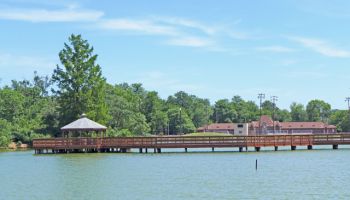
| |
| Birmingham City Parks | |
| Years | 1918–present |
|---|---|
| Location | 8101 4th Avenue North, (map) North East Lake |
| Area | 100 acres |
| Website | facebook.com |
The City of Birmingham purchased the property for $65,000 on July 14, 1917 and dedicated it as a public park on May 10, 1918. The city kept many of its attractions open over the next decades while adding other recreational facilities.
Over the next few years, some of the new features included a caterpillar ride, seaplane, "The Whip", the "Rolling Mill" and the "Old Mill" along with a riding academy, pleasure boats, playground, barbecue stand and other food and drink vendors. Prior to the summer of 1922 the city doubled the size of the bathing beach and expanded the bath houses with new lockers. Miles Bradford managed the attraction for the city.
For 1923 $40,000 in new attractions was invested, providing for a "Dodgem" ride, and what was then the longest roller coaster in the South was constructed at the park; 1/4-mile long with 14 dips, including one of 54 feet. On November 20 of that year, Wahouma's Nathan Bedford Forrest Klan No. 60 inducted 2,100 new members at a torchlit ceremony in the park. The city invested another $75,000 on improvements during the winter of 1923-1924, highlighted by a $25,000 merry-go-round completed with a calliope and 1,380 electric lights. The bathing beach was expanded and rebuilt with new diving wells dug into the lake bottom. Also added were a miniature railroad and other rides.
During the Great Depression workers from the Civil Works Administration drained a swampy area north of lake, regraded picnic and bathhouse areas, and constructed 3 tennis courts and 11 barbecue pits. The Works Progress Administration constructed an East Lake Community House and East Lake Auditorium at the park.
In the 1950s, the operation of fishing and boating privileges at East Lake was given to the Jefferson County Sportsmen's Association which fertilized and stocked the lake. A new $150,000 swimming pool was constructed by the city in 1954.
The city widened sidewalks, repaired the dam, and installed picnic shelters and new landscaping in a 1972 renovation. The pipeline from Roebuck Springs was replaced in 1976. Additional landscaping and new parking areas were completed in 1978. The path around the lake was resurfaced with crushed stone in 1980.
The city displays the flags of the home countries of its sister cities on the 1st Avenue edge of the park. In 2012 East Lake Park was listed on the Appalachian Highlands Birding Trail. In 2022 the city replaced the park's tennis courts with a $250,000 "outdoor gym" with accessible workout equipment.
References
- Brabston, Thomas de Granville (April 20, 1904) "Birmingham Railway, Light & Power Co." Street Railway Review. Vol. 14, No. 4, pp. 225-237
- "East Lake Park Opens May 10" (May 13, 1922) Billboard, p. 70
- Lowry, Walton (1953) "East Lake poses problem for Park Board" The Birmingham News - via Birmingham Public Library Digital Collections
- "Looking back: Lake Como, East Lake, 1887" (October 18, 1959) The Birmingham News - via Birmingham Public Library Digital Collections
- Hudson, Alvin W. & Harold E. Cox (1976) Street Railways of Birmingham. Forty Fort, Pennsylvania: Harold E. Cox
- Jones, Pam. (Spring 2006) "The Hawes Murders." Alabama Heritage. No. 80, pp. 34-40
- Spencer, Thomas (May 4, 2012) "East Lake Park joins new Appalachian Highlands Birding Trail." The Birmingham News
- Byington, Pat (April 14, 2022) "Birmingham is turning the East Lake Park tennis courts into a new innovative outdoor gym." Bham Now
